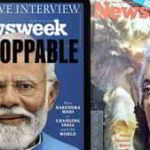ENGLISH QUIZ
Directions (Q. Nos. 1 to 15): Read the following passage carefully and answer the questions given below it. Certain words / phrases have been printed in bold to help you locate them while answering some of the questions.
A new analysis has determined that the threat of global warming can still be greatly diminished if nations cut emissions of heat-trapping green-house gases by 70% this century. The analysis was done by scientists at the National Centre for Atmospheric Research (NCAR). While global temperatures would rise, the most dangerous potential aspects of climate change, including massive losses of Arctic sea ice and permafrost and significant sea-level rise. could be partially avoided.
“This research indicates that we can no longer avoid significant warming during this century,” said NCAR scientist Warren Washington, the study paper’s lead author. “But, if the world were to implement this level of emission cuts, we could stabilise the threat of climate change”, he added.
Average global temperatures have warmed by close to 1°C since the pre-industrial era. Much of the warming is due to human-produced emissions of greenhouse gases, predominantly carbon dioxide. This heat-trapping gas has increased from a pre-industrial level of about 284 parts per million (ppm) in the atmosphere to more than 380 ppm today. With research showing that additional warming of about 1°C may be the threshold for dangerous climate change, the European Union has called for dramatic cuts in emissions of carbon dioxide and other greenhouse gases.
To examine the impact of such cuts on the world’s climate, Washington and his colleagues ran a series of global studies with the NCAR-based Community Climate System Model (CCSM). They assumed that carbon dioxide levels could be held to 450 ppm at the end of this century. In contrast, emissions are now on track to reach about 750 ppm by 2100 if unchecked. The team’s results showed that if carbon dioxide were held to 450 ppm, global temperatures would increase by 0.6°C above current readings by the end of the century. In contrast, the study showed that temperatures would rise by almost four times that amount, to 2.2°C above current readings, if emissions were allowed to continue on their present course. Holding carbon dioxide levels to 450 ppm would have other impacts, according to the climate modeling study.
Sea-level rise due to thermal expansion as water temperatures warmed would be 14 cm (about 5.5 inches) instead of 22 cm (8.7 inches). Also, Arctic ice in the summertime would shrink by about a quarter in volume and stabilise by 2100, as opposed to shrinking at least three-quarters and continuing to melt, and Arctic warming would be reduced by almost half.
1. Why has the European Union called for dramatic cuts in carbon dioxide and green-house gas emissions?
a. As global warming is not an issue of concern
b. As the temperatures may rise almost by an additional 1°C and this may lead to severe climate change
c. As the NCAR has forced the European Union to announce the cuts
d. As all the nations have decided to cut emissions of carbon dioxide
e. None of the above
2. What would not be one of the impacts of cutting green-house gas emissions?
a. Temperatures will stop soaring
b. Ice in the Arctic sea would melt at a slower pace
c. The rise in sea level would be lesser
d. All of the above would be the impact
e. None of the above
3. What would be the impact of unchecked green-house gas and carbon dioxide emissions?
a. The temperature would rise from the current temperature by 2.2°C
b. The sea-level would rise by about 5.5 inches
c. The Arctic ice would stabilise by 2100
d. The Arctic ice would reduce by one-fourth
e. None of the above
4. What can be the most appropriate title of the above passage?
a. A study of the rise in water level
b. A study of rise in temperatures
c. A study of the effects of green-house gas emissions
d. A study of the Arctice region
e. A study of change in seasons
5. Which of the following statements in true in context of the passage?
a. At present, the carbon dioxide emission is about 284 ppm.
b. The carbon dioxide emissions will be about 450 ppm at the end of this century if unchecked
c. The carbon dioxide emission was about 380 ppm during the pre-industrial era
d. The carbon dioxide emissions will be about 750 ppm at the end of this century if unchecked
e. None of the above
6. What does the scientist Warren Washington mean when he says “we could stabilise the threat of climate change”?
a. Climate change can be stopped completely
b. Climate change can be regularised
c. Climate change and its effects can be studied extensively
d. The ill-effects of the change in climate can be minimised
e. None of these above
7. Why did Washington and his colleagues conduct a series of studies?
a. Because they realized that the temperature increase was almost about 1°C
b. So that they could stabilise the climate change
c. So that they could help the European Union in cutting the carbon dioxide emissions
d. Because they found out that the green-house gas emissions could be cut by 70%
e. None of the above
8. What would be the impact of holding the carbon dioxide level at 450 ppm at the end of this century?
A. Global temperatures would increase by 0.6 degrees Celcius.
B. Arctic warming would be reduced by half.
C. Themal expansion will stop completely.
a. Only A
b. Only A and B
c. Only B and C
d. All the three A, B and C
e. None of these above
Directions (Q. Nos. 9 to 12): Choose the word which is most similar in meaning to the word printed in bold as used in the passage.
9. Dramatic
a. Unprecedented
b. Thrilling
c. Spectacular
d. Effective
e. feeble
10. Shrink
a. Contract
b. Physician
c. Wither
d. Shrivel
e. Reduce
11. Predominantly
a. Clearly
b. Aggressively
c. Mainly
d. Firstly
e. Faintly
12. Massive
a. Tall
b. Tough
c. Total
d. Little
e. Severe
Directions (Q. Nos. 13 to 15): Choose the word which is most opposite in meaning to the word printed in bold as used in the passage.
13. Significant
a. Substantial
b. Miniscule
c. Incoherent
d. Unimportant
e. Irrelevant
14. Opposed
a. Resistant
b. Against
c. Favouring
d. Similar
e. Agree
15. Diminished
a. Created
b. Rose
c. Increased
d. Lessen
e. Finished
Directions (Q. Nos. 16 to 20): Which of the phrases (a), (b), (c) and (d) given below each sentence should replace the phrases printed in bold in the sentence to make it grammatically correct? If the sentence is correct as it is given and no correction is required, mark (e) as the answer.
16. Although scared of heights, she gather all her courage and stood atop the 24-storey building to participate in the activities.
a. gathered all her courage
b. gathered all courageous
c. gather all courageous
d. is gathered all courage
e. No correction required
17. Naturally, with everything gone so well for them, it was time for celebration.
a. go so well
b. going so well
c. gone as well
d. going as well
e. No correction required
18. The ban was imposed by the state’s commercial taxes department last Friday after protests by a certain community, which has threat to burn cinema halls screening the controversial movie.
a. had threats of burning
b. had threated to burn
c. had threatened to burn
d. had threatened to burning
e. No correction required
19. Rakesh, an avid football player who captained his team in school and college, will inaugurate the match tomorrow in Pune.
a. will be inaugurate
b. in inauguration
c. will inaugurating
d. is inaugurate
e. No correction required
20. At a musical night organised for them, the artistic side of the doctors came as forward, as they sang beautifully and made the evening truly memorable.
a. come forward
b. come to the fore
c. came to the forth
d. came to the fore
e. No correction required
ANSWERS
1. B
2. D
3. A
4. C
5. D
6. D
7. E
8. B
9. A
10. E
11. C
12. E
13. D
14. D
15. C
16. A
17. B
18. C
19. E
20. D











